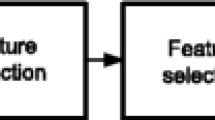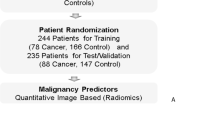Abstract
Lung cancer is the leading cause of cancer-related deaths in the world, and one of its manifestations occurs with the appearance of pulmonary nodules. The classification of pulmonary nodules may be a complex task to specialists due to temporal, subjective, and qualitative aspects. Therefore, it is important to integrate computational tools to the early pulmonary nodule classification process, since they have the potential to characterize objectively and quantitatively the lesions. In this context, the goal of this work is to perform the classification of pulmonary nodules based on image features of texture and margin sharpness. Computed tomography scans were obtained from a publicly available image database. Texture attributes were extracted from a co-occurrence matrix obtained from the nodule volume. Margin sharpness attributes were extracted from perpendicular lines drawn over the borders on all nodule slices. Feature selection was performed by different algorithms. Classification was performed by several machine learning classifiers and assessed by the area under the receiver operating characteristic curve, sensitivity, specificity, and accuracy. Highest classification performance was obtained by a random forest algorithm with all 48 extracted features. However, a decision tree using only two selected features obtained statistically equivalent performance on sensitivity and specificity.



Similar content being viewed by others
References
Wu H, Sun T, Wang J, Li X, Wang W, Huo D, Lv P, He W, Wang K, Guo X: Combination of radiological and gray level co-occurrence matrix textural features used to distinguish solitary pulmonary nodules by computed tomography. J Digit Imaging 26(4):797–802, 2013
Truong MT, Ko JP, Rossi SE, Rossi I, Viswanathan C, Bruzzi JF, Marom EM, Erasmus JJ: Update in the evaluation of the solitary pulmonary nodule. Radiographics 34(6):1658–1679, 2014
Wang YJ, Gong J, Suzuki K, Morcos SK: Evidence based imaging strategies for solitary pulmonary nodule. Journal of Thoracic Disease 6(7):872, 2014
Aerts HJ, Velazquez ER, Leijenaar RT, Parmar C, Grossmann P, Cavalho S, Bussink J, Monshouwer R, Haibe-Kains B, Rietveld D, Hoebers F, Rietbergen MM, Leemans CR, Dekker A, Quackenbush J, Gillies RJ, Lambin P: Decoding tumour phenotype by noninvasive imaging using a quantitative radiomics approach. Nat Commun 5:4006, 2014
Awai K, Murao K, Ozawa A, Nakayama Y, Nakaura T, Liu D, Kawanaka K, Funama Y, Morishita S, Yamashita Y: Pulmonary nodules: estimation of malignancy at thin-section helical CT—effect of computer-aided diagnosis on performance of radiologists. Radiology 239(1):276–284, 2006
Iwano S, Nakamura T, Kamioka Y, Ikeda M, Ishigaki T: Computer-aided differentiation of malignant from benign solitary pulmonary nodules imaged by high-resolution CT. Comput Med Imaging Graph 32(5):416–422, 2008
Doi K: Computer-aided diagnosis in medical imaging: historical review, current status and future potential. Comput Med Imaging Graph 31(4-5):198–211, 2007
Cataldo S, Bottino A, Islam I, Vieira T, Ficarra E: Subclass discriminant analysis of morphological and textural features for hep-2 staining pattern classification. Pattern Recogn 47(7):2389–2399, 2014
Tartar A, Kilic N, Akan A: Classification of pulmonary nodules by using hybrid features. Comput Math Methods Med 2013:1–11, 2013
Reeves AP, Xie Y, Jirapatnakul A: Automated pulmonary nodule CT image characterization in lung cancer screening. Int J Comput Assist Radiol Surg 11(1):73–88, 2016
Dilger S, Judisch A, Uthoff J, Hammond E, Newell J, Sieren, J: Improved pulmonary nodule classification utilizing lung parenchyma texture features. In: SPIE Medical Imaging. International Society for Optics and Photonics, 2015, pp 94142T–94142T
Zhang F, Song Y, Cai W, Lee M, Zhou Y, Huang H, Shan S, Fulham MJ, Feng DD: Lung nodule classification with multilevel patch-based context analysis. IEEE Transactions on Biomedical Engineering 61(4):1155–1166, 2014
Kaya A, Can A: A weighted rule based method for predicting malignancy of pulmonary nodules by nodule characteristics. J Biomed Inform 56:69–79, 2015
Ferreira Jr, JR, Oliveira MC, Azevedo-Marques PM: Pulmonary nodule classification with 3D features of texture and margin sharpness. Int J Comput Assist Radiol Surg 11(S1):S272–S272, 2016
Levman JE, Martel AL: A margin sharpness measurement for the diagnosis of breast cancer from magnetic resonance imaging examinations. Acad Radiol 18(12):1577–1581, 2011
Khasnobish A, Pal M, Tibarewala DN, Konar A, Pal K: Texture-and deformability-based surface recognition by tactile image analysis. Med Biol Eng Comput 54(8):1269–1283, 2016
Armato III SG, Mclennan G, Bidaut L, Mcnitt-Gray MF, Meyer CR, Reeves AP, Zhao B, Aberle DR, Henschke CI, Hoffman EA, Kazerooni EA, Macmahon H, Beek EJRV, Yankelevitz D, Biancardi AM, Bland PH, Brown MS: The lung image database consortium (LIDC) and image database resource initiative (IDRI): a completed reference database of lung nodules on CT scans. Med Phys 38:915–931, 2011
Armato III S, McLennan G, Bidaut L, McNitt-Gray M, Meyer C, Reeves A, Clarke L: Data from LIDC-IDRI. The cancer imaging archive. https://doi.org/10.7937/k9/TCIA.2015.LO9QL9SX, 2015
Ferreira Jr, JR, Oliveira MC, Azevedo-Marques PM: Cloud-based noSQL open database of pulmonary nodules for computer-aided lung cancer diagnosis and reproducible research. J Digit Imaging 29(6):716–729, 2016
Haralick R, Shanmugam K, Dinstein I: Textural features for image classification. IEEE Trans Syst Man Cybern 6:610–621, 1973
Almeida E, Rangayyan RM, Azevedo-Marques PM: Gaussian mixture modeling for statistical analysis of features of high-resolution CT images of diffuse pulmonary diseases. In: Proceedings of the 2015 IEEE International Symposium on Medical Measurements and Applications (MeMeA), 2015, pp 1–5
Hall M: Correlation-based feature selection for machine learning. PhD thesis, Department of Computer Science, The University of Waikato, New Zealand, 1999
Witten IH, Frank E: Data mining: Practical machine learning tools and techniques. San Mateo: Morgan Kaufmann, 2005
Kohavi R, John G: Wrappers for feature subset selection. Artif Intell 97(1-2):273–324, 1997
Park SH, Goo JM, Jo C: Receiver operating characteristic (ROC) curve: practical review for radiologists. Korean J Radiol 5(1):11–18, 2004
Tamura H, Mori S, Yamawaki T: Textural features corresponding to visual perception. IEEE Trans Syst Man Cybern 8(6):460–473, 1978
Mallat SG: A theory for multiresolution signal decomposition: the wavelet representation. IEEE Trans Pattern Anal Mach Intell 11(7):674–693, 1989
Vittitoe NF, Baker JA, Floyd CE: Fractal texture analysis in computer-aided diagnosis of solitary pulmonary nodules. Acad Radiol 4(2):96–101, 1997
Lucena DJF, Ferreira Jr JR, Machado AP, Oliveira MC: Automatic weighing attribute to retrieve similar lung cancer nodules. BMC Med Inform Decis Mak 16(2):135–149, 2016
Shen W, Zhou M, Yang F, Yu D, Dong D, Yang C, Zang Y, Tian J: Multi-crop convolutional neural networks for lung nodule malignancy suspiciousness classification. Pattern Recognit 61:663–673, 2017
Funding
This study was funded by Fundação de Amparo à Pesquisa do Estado de Alagoas and Coordenação de Aperfeiçoamento de Pessoal de Nível Superior (grant no. 20130603-002-0040-0063)
Author information
Authors and Affiliations
Corresponding author
Ethics declarations
Conflict of interests
The authors declare that they have no conflict of interest.
Ethical approval
For this type of study formal consent is not required. This study used a public image database (https://doi.org/10.7937/K9/TCIA.2015.LO9QL9SX), which all protected health information (PHI) contained within the DICOM headers of the images were removed in accordance with Health Insurance Portability and Accountability Act (HIPAA) guidelines.
Rights and permissions
About this article
Cite this article
Ferreira, J.R., Oliveira, M.C. & de Azevedo-Marques, P.M. Characterization of Pulmonary Nodules Based on Features of Margin Sharpness and Texture. J Digit Imaging 31, 451–463 (2018). https://doi.org/10.1007/s10278-017-0029-8
Published:
Issue Date:
DOI: https://doi.org/10.1007/s10278-017-0029-8




